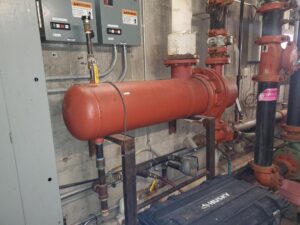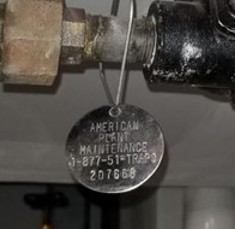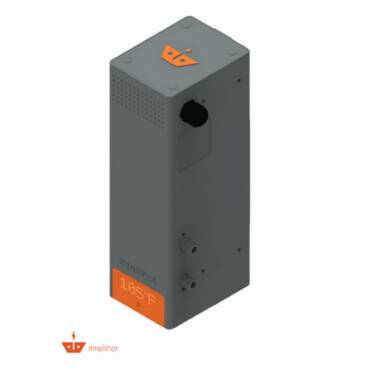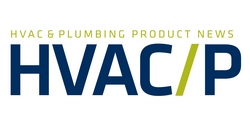By Ricardo Aguirre
Heat exchangers are used to transfer thermal energy from one type of liquid or steam source to another kind of liquid source at a wide range of facilities. Whether heating a space or some type of fluid in a manufacturing process, using leftover heat is an energy-efficient way to preheat another system. The process requires maintaining effective heat transfer between the two sources, which is why regular testing and maintenance of the heat exchanger is so crucial to efficient and trouble-free operations.
Regular heat exchanger assessments are a great way to achieve trouble-free operations. The four most important objectives of such a program – which should include testing, maintenance and repairs – are ensuring operational integrity, guaranteeing thermal efficiency, promoting water conservation and promoting chemical conservation.
Operational integrity: A heat exchange assessment should begin with basic identification and documentation of the heat exchangers. The documentation should include the tag #, location, type, manufacturer, model and application.
For example, APM heat exchanger surveys identify each exchanger with a unique number on a stainless steel tag, which provides a quick and easy way to reference the heat exchanger’s location and information.
Hydrostatic pressure testing is then conducted, in which the heat exchanger is taken offline to identify and verify the functionality of isolation valves and ports for cleaning. Pressure testing will then be carried out. Fluid is run through the heat exchanger at a pressure slightly above the operating pressure to enable investigators to determine if there is a leak from one medium to the other (e.g., from the water side to the steam side).
Heat exchanger survey reports include summary data listing the total number of exchangers, highlighting those with “function-impeding issues,” and a graphic presentation of results. Information includes total estimated annual steam losses, total estimated annual therm losses, heat exchanger valve status and tube bundle failures.
In the case of leaking heat exchangers, the assessment will include measurements of the water volume leaking, the temperature coming from the tap water and the temperature desired as an output. A spreadsheet is developed to calculate how much energy is lost, which can be used by utilities to provide incentives to repair leaking heat exchangers.
All operational integrity information is folded into a final report with assessment details, along with information on the cost of cleaning each heat exchanger and/or any necessary repair costs. If there are no leaks, borescope pictures can be used to capture visual assessment and prove scale build up in the bundle and an assessment of whether it can be cleaned in the future. If necessary, the report might include suggestions for installation of a port that allows for cleaning-in-place procedures.
Thermal efficiency: Since fuel is being used to create heat, ensure the heat goes where it is intended. In a catastrophic scenario, for example, a leaking heat exchanger, water that had been heated up to a certain required temperature is leaking from the water side into the steam side and flowing away with condensate. That water must be replenished, and, since replenishment water will be street water that usually comes in at a temperature of about 60-65 F, it will take considerable energy to be heated up again to the desired output temperature of 130 F. This waste of water that has already been heated represents a serious loss of thermal efficiency.
Buildup of whiteish scale on the water side of the heat exchanger also prevents the efficient transfer of heat. In addition, the scale buildup starts to reduce the volume of medium that can go through that heat exchanger, so all things being equal, it will take more time to get the same amount of water out as the scale builds up and reduces the element’s usable volume. In this case, thermal efficiency is improved by descaling using a clean-in-place process, which is far less disruptive for facilities and operations personnel.
Water conservation: In the case of a leaking bundle in a heat exchanger, water must be replenished, which can result in significant additional costs, depending upon the community water costs.
Chemical conservation: This element is especially critical for steam production applications. The makeup water going into the boiler for making steam is highly treated with chemicals, including corrosion inhibitors and other chemicals to prevent bubbling up and wet steam in the system. Operators producing steam are looking to capture all the heat out of that steam, then return the steam that turns into condensate to the boiler. In effect, the condensate is like liquid gold; operators seek to preserve as much condensate as possible and bring it back to the boiler. A leaking heat exchanger leads to diluting water. The water ends up colder and lacking the right chemistry, so more water must be added to restore that chemistry. If not caught in time, the boiler can corrode quickly.
 Establishing return on investment for heat exchanger maintenance activities
Establishing return on investment for heat exchanger maintenance activities
The heat exchanger assessment program, which should be undertaken at least every three years, should include energy savings calculations with return-on-investment data so operators can evaluate the business case for performing the cleaning and get an estimate of the significant overall savings that can be achieved. The information includes a calculation of approximate heat exchanger cleaning program payback time in years, based on assumptions for cost of steam, percentage transfer loss due to scale buildup and fouled heat exchangers.
In an area of poor water quality (e.g., one with hard water that creates a lot of scaling), operators might test more often, while areas with good water treatment may not require more frequent testing. Testing should ensure that heat exchangers are hitting their set points, are free of scale, and are not leaking. Regularly making sure that is the case and addressing issues promptly is the way to go. Scale buildup over time degrades the system and is likely to lead to more issues.
Staying on top of issues is more cost effective than waiting for things to fail
Heat exchangers are vital equipment in a facility, and problems are not always visible. Failed tube bundles and heat exchanger isolation valves can adversely affect operational integrity of building heat, domestic hot water or other facility processes. Conducting a regular heat exchanger assessment and following up with cleaning and repairs saves time and money.
Ricardo Aguirre is CEO of American Plant Maintenance (APM Steam), a facility services contractor focused on energy efficiency audits and projects related to steam systems at hospitals, pharmaceuticals and universities.

Whether you require installation, repair, or maintenance, our technicians will assist you with top-quality service at any time of the day or night. Take comfort in knowing your indoor air quality is the best it can be with MOE heating & cooling services Ontario's solution for heating, air conditioning, and ventilation that’s cooler than the rest.
Contact us to schedule a visit. Our qualified team of technicians, are always ready to help you and guide you for heating and cooling issues. Weather you want to replace an old furnace or install a brand new air conditioner, we are here to help you. Our main office is at Kitchener but we can service most of Ontario's cities
Source link



